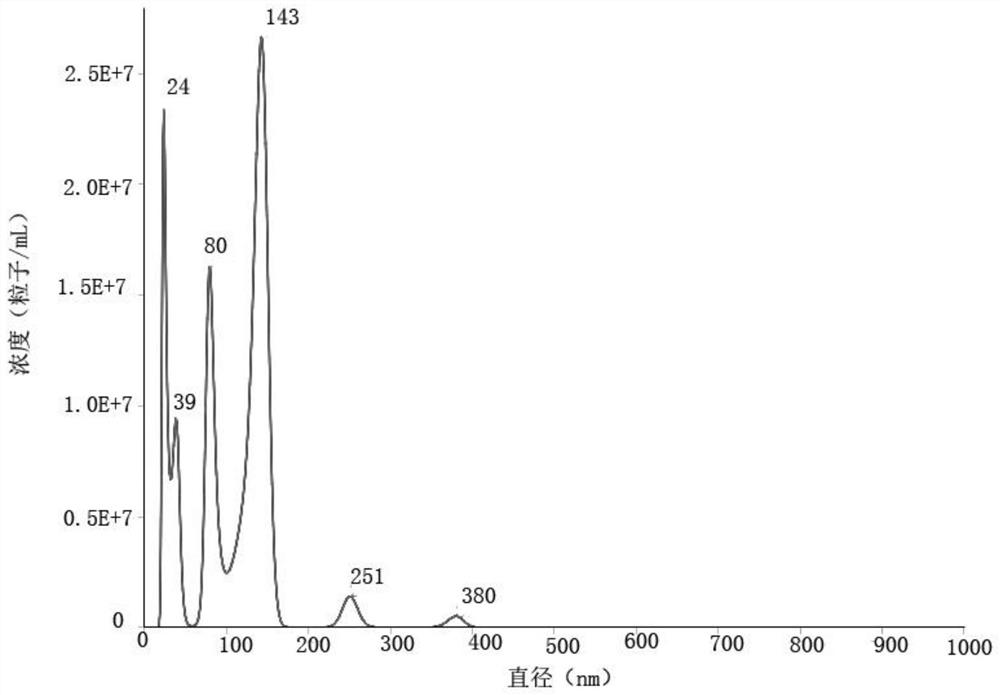Exosome extraction and separation method of seawater parasitic ciliate cryptocaryon irritans and application
A technology that stimulates Cryptocaryonia and separates it. It is applied in the field of extraction and separation of exosomes. It can solve the problems of high mortality, fast spread, and destructive death of fish, and achieve the effect of improving purity and reducing the difficulty of separation.
- Summary
- Abstract
- Description
- Claims
- Application Information
AI Technical Summary
Problems solved by technology
Method used
Image
Examples
Embodiment 1
[0030] A method for extracting and separating exosomes from seawater parasitic ciliates stimulating Cryptocaryon, comprising the following steps:
[0031] Step 1. After collecting Cryptocaryonia stimuli cysts, the cysts are cleaned and incubated in sterile seawater containing antibiotics;
[0032] Step 2: Cyst hatching, after the infectious larvae escape, use a sterile filter to collect the infectious larvae, and incubate in seawater isotonic Leibovitz's L-15 cell culture medium containing antibiotics and exosome-free fetal bovine serum ;
[0033] Step 3, centrifuging to remove the infected stage larvae, and collecting the supernatant;
[0034] Step 4, the supernatant is sterilized through a 0.22 μm filter membrane, and the filtrate is concentrated to obtain a concentrate;
[0035] Step 5, the concentrated solution is centrifuged to collect the coarse precipitate of exosomes;
[0036] Step 6. The crude exosome pellet was resuspended in sterile pre-cooled PBS, and 1×HALT pro...
Embodiment 2
[0039] A method for extracting and separating exosomes from seawater parasitic ciliates stimulating Cryptocaryon, comprising the following steps:
[0040] Step 1. After collecting Cryptocaryon stimuli cysts, clean the cysts and place them in sterile seawater containing antibiotics for incubation; wherein, the antibiotics are 100I.U.ml –1 Penicillin, 80 μg ml –1 streptomycin sulfate;
[0041] Step 2: Cyst hatching, after the infectious larvae escape, use a sterile filter to collect the infectious larvae, and incubate in seawater isotonic Leibovitz's L-15 cell culture medium containing antibiotics and exosome-free fetal bovine serum ;
[0042] Step 3, centrifuging to remove the infected stage larvae, and collecting the supernatant;
[0043] Step 4, the supernatant is sterilized through a 0.22 μm filter membrane, and the filtrate is concentrated to obtain a concentrate;
[0044] Step 5, the concentrated solution is centrifuged to collect the coarse precipitate of exosomes;
...
Embodiment 3
[0048] A method for extracting and separating exosomes from seawater parasitic ciliates stimulating Cryptocaryon, comprising the following steps:
[0049] Step 1. After collecting Cryptocaryon stimuli cysts, clean the cysts and place them in sterile seawater containing antibiotics for incubation; wherein, the antibiotics are 80I.U.ml –1 Penicillin, 80 μg ml –1 streptomycin sulfate;
[0050]Step 2: Cyst hatching, after the infectious larvae escape, use a sterile filter to collect the infectious larvae, and incubate in seawater isotonic Leibovitz's L-15 cell culture medium containing antibiotics and exosome-free fetal bovine serum ; Among them, the larvae in the infecting period were collected by a sterile filter and diluted to 1×10 6 id / ml concentration cultivation, the mass fraction of exosome-free fetal bovine serum in the medium is 15%, the incubation temperature is 25°C, and the incubation is 4h;
[0051] Step 3, centrifuging to remove the infected stage larvae, and coll...
PUM
 Login to View More
Login to View More Abstract
Description
Claims
Application Information
 Login to View More
Login to View More - R&D
- Intellectual Property
- Life Sciences
- Materials
- Tech Scout
- Unparalleled Data Quality
- Higher Quality Content
- 60% Fewer Hallucinations
Browse by: Latest US Patents, China's latest patents, Technical Efficacy Thesaurus, Application Domain, Technology Topic, Popular Technical Reports.
© 2025 PatSnap. All rights reserved.Legal|Privacy policy|Modern Slavery Act Transparency Statement|Sitemap|About US| Contact US: help@patsnap.com


